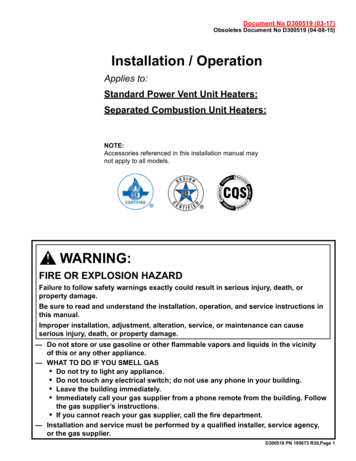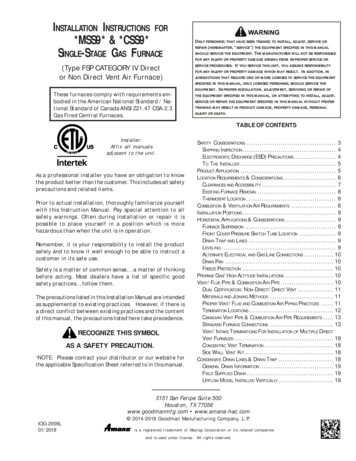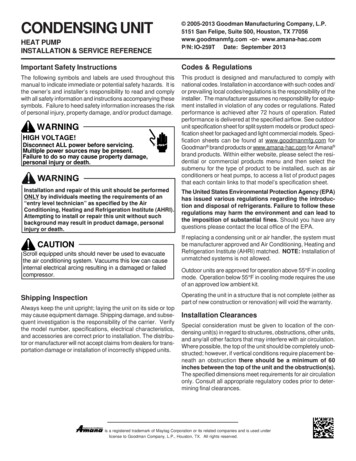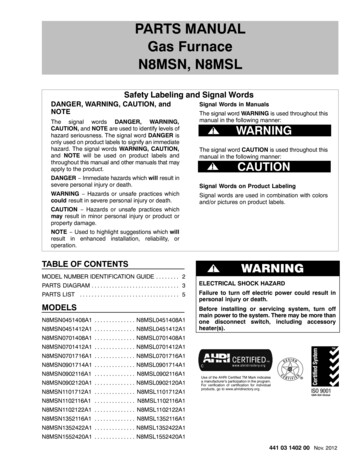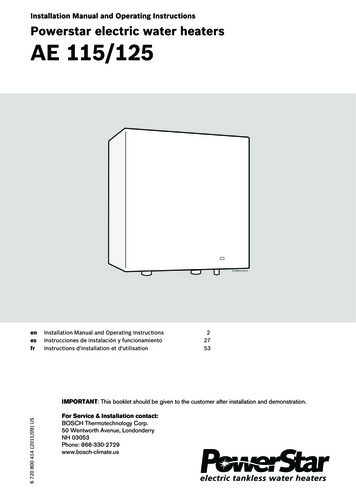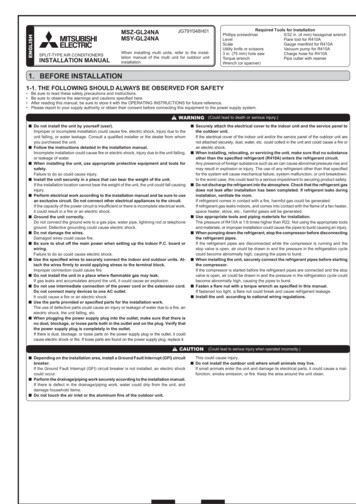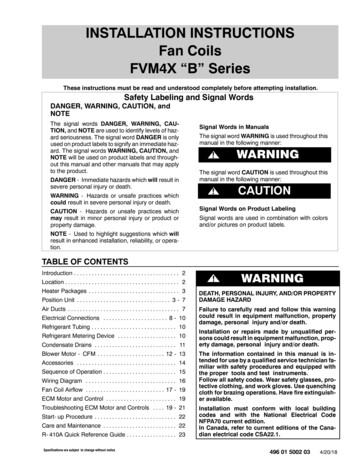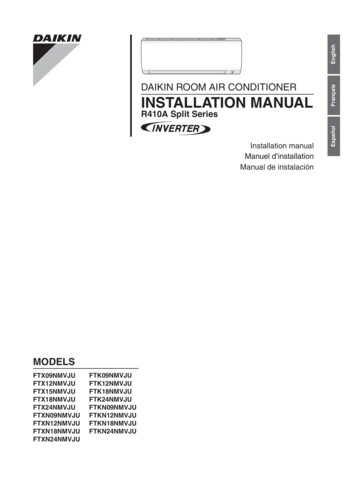
Transcription
EnglishINSTALLATION MANUALFrançaisDAIKIN ROOM AIR CONDITIONERInstallation manualManuel dinstallationManual de instalaciónEspañolR410A Split 4NMVJU00 CV 3P379970-5B.indd JUFTKN12NMVJUFTKN18NMVJUFTKN24NMVJU9/10/2015 14:20:54
ContentsSafety Considerations . 1Accessories . 3Refrigerant Piping Work . 91. Flaring the pipe end. 92. Refrigerant piping. 9Choosing an Installation Site . 3Installation Tips . 101. Indoor unit. 31. Removing and installing the front panel. 102. Wireless remote controller. 32. Removing and installing the front grille. 11Indoor Unit Installation Diagram . 43. How to set the different addresses. 11Trial Operation and Testing . 12Indoor Unit Installation . 51. Installing the mounting plate. 51. Trial operation and testing. 122. Test items. 122. Drilling a wall hole and installing wall embedded pipe. 63. Installing the indoor unit. 64. Wiring. 85. Drain piping. 8Safety ConsiderationsRead these Safety Considerations for Installation carefullybefore installing an air conditioner or heat pump. After completingthe installation, make sure that the unit operates properly duringthe startup operation.Instruct the user on how to operate and maintain the unit.Inform users that they should store this installation manual withthe operation manual for future reference.Always use a licensed installer or contractor to install this product.Improper installation can result in water or refrigerant leakage,electric shock, fire, or explosion.Meanings of DANGER, WARNING, CAUTION, and NOTESymbols:DANGER Indicates an imminently hazardoussituation which, if not avoided, willresult in death or serious injury.Indicates a potentially hazardous WARNINGsituation which, if not avoided, couldresult in death or serious injury.Indicates a potentially hazardous CAUTIONsituation which, if not avoided, mayresult in minor or moderate injury.It may also be used to alert againstunsafe practices.Indicates situations that may result NOTEin equipment or property-damageaccidents only.DANGER Refrigerant gas is heavier than air and replaces oxygen.A massive leak can lead to oxygen depletion, especiallyin basements, and an asphyxiation hazard could occurleading to serious injury or death. Do not ground units to water pipes, gas pipes, telephonewires, or lightning rods as incomplete grounding can causea severe shock hazard resulting in severe injury or death.Additionally, grounding to gas pipes could cause a gas leakand potential explosion causing severe injury or death.101 EN 3P379970-5B.indd 1 If refrigerant gas leaks during installation, ventilate thearea immediately. Refrigerant gas may produce toxic gasif it comes into contact with fire. Exposure to this gas couldcause severe injury or death. After completing the installation work, check that therefrigerant gas does not leak throughout the system. Do not install unit in an area where flammable materialsare present due to risk of explosions that can causeserious injury or death. Safely dispose all packing and transportation materialsin accordance with federal/state/local laws or ordinances.Packing materials such as nails and other metal orwood parts, including plastic packing materials used fortransportation may cause injuries or death by suffocation.WARNING Only qualified personnel must carry out the installationwork. Installation must be done in accordance with thisinstallation manual. Improper installation may result inwater leakage, electric shock, or fire. When installing the unit in a small room, take measuresto keep the refrigerant concentration from exceedingallowable safety limits. Excessive refrigerant leaks, in theevent of an accident in a closed ambient space, can leadto oxygen deficiency. Use only specified accessories and parts for installationwork. Failure to use specified parts may result in waterleakage, electric shock, fire, or the unit falling. Install the air conditioner or heat pump on a foundationstrong enough that it can withstand the weight of the unit.A foundation of insufficient strength may result in the unitfalling and causing injuries. Take into account strong winds, typhoons, or earthquakeswhen installing. Improper installation may result in the unitfalling and causing accidents. English10/29/2015 16:20:59
Make sure that all wiring is secured, that specified wiresare used, and that no external forces act on the terminalconnections or wires. Improper connections or installationmay result in fire. When wiring, position the wires so that the electricalwiring box cover can be securely fastened. Improperpositioning of the electrical wiring box cover may result inelectric shock, fire, or the terminals overheating. Before touching electrical parts, turn off the unit. It is recommended to install a ground fault circuitinterrupter if one is not already available. This helpsprevent electric shock or fire. Securely fasten the outdoor unit terminal cover (panel). If theterminal cover/panel is not installed properly, dust or watermay enter the outdoor unit causing fire or electric shock. When installing or relocating the system, keep the refrigerantcircuit free from substances other than the specifiedrefrigerant (R410A) such as air. Any presence of air or otherforeign substance in the refrigerant circuit can cause anabnormal pressure rise or rupture, resulting in injury. Do not change the setting of the protection devices. If thepressure switch, thermal switch, or other protection deviceis shorted and operated forcibly, or parts other than thosespecified by Daikin are used, fire or explosion may occur.CAUTION Do not touch the switch with wet fingers. Touching a switchwith wet fingers can cause electric shock. Do not allow children to play on or around the unit toprevent injury. The heat exchanger fins are sharp enough to cut. To avoidinjury wear gloves or cover the fins while working aroundthem. Do not touch the refrigerant pipes during and immediatelyafter operation as the refrigerant pipes may be hot orcold, depending on the condition of the refrigerant flowingthrough the refrigerant piping, compressor, and otherrefrigerant cycle parts. Your hands may suffer burns orfrostbite if you touch the refrigerant pipes. To avoid injury,give the pipes time to return to normal temperature or, ifyou must touch them, be sure to wear proper gloves. Install drain piping to proper drainage. Improper drainpiping may result in water leakage and property damage. Insulate piping to prevent condensation. Be careful when transporting the product. Do not turn off the power immediately after stoppingoperation. Always wait for at least 5 minutes before turningoff the power. Otherwise, water leakage may occur. Do not use a charging cylinder. Using a charging cylindermay cause the refrigerant to deteriorate. Refrigerant R410A in the system must be kept clean, dry,and tight.(a) Clean and Dry -- Foreign materials (including mineraloils such as SUNISO oil or moisture) should beprevented from getting into the system. English01 EN 3P379970-5B.indd 2(b) Tight -- R410A does not contain any chlorine, does notdestroy the ozone layer, and does not reduce the earth’sprotection again harmful ultraviolet radiation. R410Acan contribute to the greenhouse effect if it is released.Therefore take proper measures to check for the tightnessof the refrigerant piping installation. Read the chapterRefrigerant Piping Work and follow the procedures.English Make sure that a separate power supply circuit is providedfor this unit and that all electrical work is carried out byqualified personnel according to local, state, and nationalregulations. An insufficient power supply capacity orimproper electrical construction may lead to electric shockor fire. Since R410A is a blend, the required additional refrigerantmust be charged in its liquid state. If the refrigerant ischarged in a state of gas, its composition can change andthe system will not work properly. The indoor unit is for R410A. See the catalog for indoormodels that can be connected. Normal operation is notpossible when connected to other units. Remote controller (wireless kit) transmitting distance can beshorter than expected in rooms with electronic fluorescentlamps (inverter or rapid start types). Install the indoor unitfar away from fluorescent lamps as much as possible. Indoor units are for indoor installation only. Outdoor units can beinstalled either outdoors or indoors. This unit is for indoor use. Do not install the air conditioner or heat pump in thefollowing locations:(a) Where a mineral oil mist or oil spray or vapor isproduced, for example, in a kitchen.Plastic parts may deteriorate and fall off or result inwater leakage.(b) Where corrosive gas, such as sulfurous acid gas, isproduced.Corroding copper pipes or soldered parts may result inrefrigerant leakage.(c) Near machinery emitting electromagnetic waves.Electromagnetic waves may disturb the operation ofthe control system and cause the unit to malfunction.(d) Where flammable gas may leak, where there is carbonfiber, or ignitable dust suspension in the air, or wherevolatile flammables such as thinner or gasoline arehandled. Operating the unit in such conditions cancause a fire. Take adequate measures to prevent the outdoor unitfrom being used as a shelter by small animals. Smallanimals making contact with electrical parts can causemalfunctions, smoke, or fire. Instruct the user to keep thearea around the unit clean.NOTE Install the power supply and inter-unit wires for the indoorand outdoor units at least 3.5ft away from televisions orradios to prevent image interference or noise. Dependingon the radio waves, a distance of 3.5ft may not besufficient to eliminate the noise. Dismantling the unit, treatment of the refrigerant, oil andadditional parts must be done in accordance with therelevant local, state, and national regulations. Do not use the following tools that are used withconventional refrigerants: gauge manifold, charge hose, gasleak detector, reverse flow check valve, refrigerant chargebase, vacuum gauge, or refrigerant recovery equipment. If the conventional refrigerant and refrigerator oil aremixed in R410A, the refrigerant may deteriorate. This air conditioner or heat pump is an appliance thatshould not be accessible to the general public. As design pressure is 478 psi, the wall thickness of fieldinstalled pipes should be selected in accordance with therelevant local, state, and national regulations.210/29/2015 16:20:59
AccessoriesAMounting plate1BMounting plate fixing screw3/16” 1” (M4 25mm)7CTitanium apatite photocatalyticair-purifying filter *1*22DWireless remote controller1ERemote controller holder1FFixing screw for remote controllerholder 1/8” 13/16” (M3 20mm)2GDry battery AAA. LR03 (alkaline)2HIndoor unit fixing screw3/16” 1/2” (M4 12mm)2JInsulation tape1KOperation manual1LInstallation manual1MWarranty1*1 Only for FTX(K)09/12/15/18/24**2 09/12 class: without frame15/18/24 class: with frameChoosing an Installation SiteBefore choosing the installation site, obtain user approval.1. Indoor unitThe indoor unit should be positioned in a place where:1) the restrictions on the installation requirements specified in “Indoor Unit Installation Diagram” on page 4 are met,2) both the air inlet and air outlet are unobstructed,3) the unit is not exposed to direct sunlight,4) the unit is away from sources of heat or steam,5) there is no source of machine oil vapour (this may shorten the indoor unit service life),6) cool/warm air is circulated throughout the room,7) the unit is away from electronic ignition type fluorescent lamps (inverter or rapid start type) as they may affect the remotecontroller range,8) the unit is at least 3.3ft (1m) away from any television or radio set (the unit may cause interference with the picture orsound),9) no laundry equipment is nearby.2. Wireless remote controllerTurn on all the fluorescent lamps in the room, if any, and find a location where the remote controller signals are properlyreceived by the indoor unit (within 23ft (7m)).301 EN 3P379970-5B.indd 3 English10/29/2015 16:20:59
How to attach the indoor unitHook the hooks of the bottom frameto the A mounting plate.If the hooks are difficult to hook,remove the front grille.A Mounting plateHow to remove the indoor unitPush up the marked area (at thelower part of the front grille) torelease the hooks. If it is difficult to Front grillerelease, remove the front grille.A MountingplateHookBottom frameMark (rear side)The A mounting plateshould be installed on awall which can support theweight of the indoor unit.B Mounting platefixing screw3/16” 1” (M4 25mm)1-3/16” (30mm) or more from ceilingFront panelCaulkpipe holegapwith putty.1-15/16” (50mm) or morefrom walls (on both sides)Air filtersEnglishIndoor Unit Installation DiagramScrews3/16” 5/8” (M4 16mm)**The 15, 18 and 24-class modelshave 3 screws.Appearance ofindoor units maydiffer from somemodels.(This is a 09/12class illustration)Cut thermal insulationpipe to an appropriatelength and wrap it withtape, making sure that nogap is left in the insulationpipe’s cut line.Wrap the insulation pipe withthe finishing tape from bottomto top.Service lidThe service lid is removable.Opening method1) Remove the service lid screw.2) Pull out the service lid horizontally inthe direction of the arrow.3) Pull down.C Titanium apatite photocatalyticair-purifying filter (2)(FTXN or FTKN models: Sold separately.)09/12 classTitanium apatite photocatalyticair-purifying filterBefore screwing theE remote controllerholder to the wall, makesure that control signalsare properly received byindoor unit.15/18/24 classFilter frameClawTitanium apatitephotocatalyticair-purifying filterD Wireless remotecontrollerTabAir filter English01 EN 3P379970-5B.indd 4F Fixing screw for remotecontroller holder1/8” 13/16” (M3 20mm)E Remotecontroller holder410/29/2015 16:21:00
Indoor Unit Installation1.Installing the mounting plate The mounting plate should be installed on a wall which can support the weight of the indoor unit.1) Temporarily secure the mounting plate to the wall, make sure that the panel is completely level, and mark the drillingpoints on the wall.2) Secure the mounting plate to the wall with screws.Recommended mounting plate retention spots and dimensions09/12 classRecommended mounting plateretention spots (7 spots in all)Place a leveleron these tabs.Through-the-wallhole φ2-9/16 (65)1-3/4 (44.5)6-11/16(170)1-7/8 (48)1-15/16(50)Gas pipe end11-1/4 (286)30-5/16 (770)Place the pipe port coverin this pocket.Drain hose position4-5/8 (116.5)1-3/4 (44.5)11-1/4 (285)4-5/8 (117)The removed pipeport cover can bekept in the mountingplate pocket.6-11/16 (170)1-7/8 (48)13-1/4 (337)Liquid pipe endRemoved pipeport coverUse a tape measureas shown.Position the end ofthe tape measure atA Mountingplate.15/18/24 classPlace a leveleron these tabs.Recommended mounting plateretention spots (7 spots in all)5 (126.5)1-7/8 (48)6-11/16 (170)2-3/8 (60)Gas pipe end16-7/16 (417)39 (990)501 EN 3P379970-5B.indd 5Through-the-wallhole φ3-1/8 (80)1-3/4 (44.5)1-3/4 (44.5)11-5/8 (295)4-5/8 (117)6-11/16 (170)17-1/8 (435)Liquid pipe endDrain hose position2-3/8 (60)unit: inch (mm) English10/29/2015 16:21:01
English2 Drilling a wall hole and installing wall embedded pipeWARNINGFor metal frame or metal board walls, be sure to use a wall embedded pipe and wall hole cover in the feed-through hole toprevent possible heat, electric shock, or fire. Be sure to caulk the gaps around the pipes with caulking material to preventcondensation.1) Drill a feed-through hole with a φ2-9/16 inch (65mm) (for 09/12 class),φ3-1/8 inch (80mm) (for 15/18/24 class) diameter through the wall at adownward angle toward the outside.2) Insert a wall embedded pipe into the hole.3) Insert a wall hole cover into wall pipe.4) After completing refrigerant piping, wiring, and drain piping, caulk the pipehole gap with putty.3 Wall embeddedpipeInside(field supply)OutsideCaulking(field supply)Wall hole cover(field supply)φ2-9/16”09/12 class (65mm)15/18/24classφ3-1/8”(80mm)Installing the indoor unitIn the case of bending or curing refrigerant pipes, keep the following precautions in mind.Abnormal sound may be generated if improper work is conducted. Do not strongly press the refrigerant pipes onto the bottom frame. Do not strongly press the refrigerant pipes on the front grille, either.3-1 Right-side, right-back, or right-bottom piping1) Attach the drain hose to the underside of the refrigerant pipes withadhesive vinyl tape.2) Wrap the refrigerant pipes and drain hose together with J insulationtape.Right-side pipingRemove pipe portcover here forright-side piping.Right-back pipingRight-bottompipingRemove pipe port coverhere for right-bottom piping.3) Pass the drain hose and refrigerant pipes through the wall hole, then setthe indoor unit on the A mounting plate hooks by using themarkingsat the top of the indoor unit as a guide.4) Open the front panel (Refer to “Installation Tips”on page 10), then openthe service lid (Refer to “Indoor Unit Installation Diagram”on page 4).5) Pass the inter-unit wire from the outdoor unit through the feed-throughwall hole and pass to the front of indoor unit from the back. Then pullthem at front side. Bend the ends of cable tie wires upward for easierwork in advance.6) Press the bottom frame of the indoor unit with both hands to set it on theA mounting plate hooks. Make sure the wire leads do not catch on theedge of the indoor unit. English01 EN 3P379970-5B.indd 6Bind refrigerantpipe and drainhose together withJ insulation tape.A Mounting plateHang indoor unit on the hooks ofmounting plate.A MountingplateWhen stripping theends of inter-unit wirein advance, bundle the wirelead ends with tape.Inter-unitwireWire guide610/29/2015 16:21:02
Indoor Unit Installation3-2. Left-side, left-back, or left-bottom pipingHow to replace the drain plug and drain hose Replacing onto the left side1) Remove the fixing screw of drain hose on theright and remove the drain hose.2) Remove the drain plug on the left side andattach it to the right side.3) Insert the drain hose and tighten with theincluded fixing screw.Forgetting to tighten this may cause waterleakages.Drain hose attachment positionThe drain hose is on the back of the unit.Left sideRight sideFront side of unitAttachment on the left sideAttachment on the right side(factory default)Fixing screwFixing screwDrain hoseDrain hose1) Attach the drain hose to the underside of the refrigerantpipes with adhesive vinyl tape.Remove pipeport cover herefor ve pipe port cover here for left-bottom piping.Left-bottom piping2) Be sure to connect the drain plug to the drain port inplace of without drain hose.How to set the drain plug.Do not apply lubricating oil(refrigerant oil) to the drainplug when inserting it.The application oflubrication oil to the drainplug will deteriorate theplug to cause drainleakage from the plug.apNo gInsert a hexagonal wrench (3/16 inch (4mm)).3) Shape the refrigerant pipes along the pipepath marking on the A mounting plate.4) Pass the drain hose and refrigerant pipesthrough the wall hole, then position the indoor unit on the A mounting plate hooks, using themarkings at the top of the indoor unit as aguide.5) Pull in the inter-unit wire.6) Connect the refrigerant pipes.DrainhoseCaulk this holewith putty orcaulking material.7) In case of pulling the drain hose through the back of theindoor unit, wrap the refrigerant pipes and drain hosetogether with J insulation tape as shown in the rightfigure.8) To confirm that the inter-unit wire does not catch bythe indoor unit, press the bottom edge of the indoorunit with both hands until it is firmly caught by the Amounting plate hooks. Secure the indoor unit to the Amounting plate with the H indoor unit fixing screws3/16” 1/2” (M4 12mm).3-3. Wall embedded pipingFollow the instructions given under left-side, left-back, orleft-bottom piping.1) Insert the drain hose to this depth so it won’t be pulledout of the drain pipe.A Mounting plateBind with adhesivevinyl tape.Inter-unit wireDrain hose01 EN 3P379970-5B.indd 7A MountingplateRefrigerantpipesBottom frameH Indoor unit fixing screw3/16” 1/2” (M4 12mm)Insert drain hoseto this depth soit won’t be pulledout of drain pipe.1-15/16”(50mm)or moreOuter wall7Wrap J insulation tape aroundthe bent portion of the refrigerantpipes.Overlap at least half the width ofthe tape with each turn.Inner wallDrain hoseVinyl chloridedrain pipe(VP-30) English10/29/2015 16:21:03
English4 Wiring1) As shown in the illustration, insert the wires including the ground wire into the conduit and secure them with lock nut ontothe conduit mounting plate.2) Strip wire ends (3/4 inch (20mm)).3) Match wire colours with terminal numbers on the terminal block of indoor and outdoor unit and firmly secure the wires inthe corresponding terminals with screws.4) Connect the ground wire to the corresponding terminals.5) Pull the wires lightly to make sure they are securely connected.6) While close the service lid, shape the wires so that the service lid fits securely, then close the service lid.Terminal block12Firmly fix the wires with the terminal screws.Electrical wiring box3Shape wires so that theservice lid fits securely.Outdoor unitUse AWG16 if the connection wirelength is less than 33ft (10m), orAWG14 if it is 33ft (10m) or more.1 23L1 L2Wire retainerUse the specified wire type.Indoorunit123BackFirmly fix the wires withthe terminal screws.Conduit mounting plateConduitLock nutWARNING Do not use tapped wires, extension cords, or starburst connections, as they may cause overheating, electric shock, or fire. Do not use locally purchased electrical parts inside the product. (Do not branch the power for the drain pump, etc., from theterminal block.) Doing so may cause electric shock or fire. Do not connect the power wire to the indoor unit. Doing so may cause electric shock or fire.5 Drain piping1) Connect the drain hose, as described on the right.The drain hose shouldbe inclined downward.No trap is permitted.Do not put the endof the hose in water.φ5/8”(φ16mm)2) Remove the air filters and pour some water into the drain pan to check thewater flows smoothly.3) If drain hose extension or embedded drain piping is required, use appropriateparts that match the hose front end.Drain hose suppliedwith the indoor unit English01 EN 3P379970-5B.indd 8Indoor unitdrain hoseφ5/8”(φ16mm)φ5/8”(φ16mm)Figure of hose front end4) When extending the drain hose, use a commercially availableextension hose with an inner diameter of 5/8 inch (16mm).Be sure to thermally insulate the indoor section of theextension hose.Extension drain hoseHeat insulation tube(field supply)810/29/2015 16:21:03
Refrigerant Piping Work1.Flaring the pipe end1) Cut the pipe end with a pipe cutter.2) Remove burrs with the cut surface facing downward,so that the filings do not enter the pipe.3) Put the flare nut on the pipe.4) Flare the pipe.5) Check that the flaring has been done correctly.Cut exactly atright angles.Set exactly at the position shown below.Flare tool for R410AAClutch-typeDieA0-0.020 inch(0-0.5mm)Remove burrs.FlaringConventional flare toolClutch-type (Rigid-type) Wing-nut type (Imperial-type)0.039-0.059 inch(1.0-1.5mm)0.059-0.079 inch(1.5-2.0mm)The flare's innersurface must beflaw-free.CheckThe pipe end mustbe evenly flared ina perfect circle.Make sure that theflare nut is fitted.WARNING 2.Do not apply mineral oil to the flare.Prevent mineral oil from getting into the system as this would reduce the service life of the units.Never use piping which has been used for previous installations. Only use parts which are delivered with this unit.Never install a dryer to this R410A unit in order to guarantee its service life.The drying material may dissolve and damage the system.Incomplete flaring may result in refrigerant gas leakage.Refrigerant pipingCAUTION Use the flare nut fixed to the main unit. (This is to prevent the flare nut from cracking as a result of deterioration over time.) To prevent gas leakage, apply refrigeration oil only to the inner surface of the flare. (Use refrigeration oil for R410A.) Use a torque wrench when tightening the flare nuts to prevent damage to the flare nuts and gas leakage. Align the centers of both flares and tighten the flare nuts 3 or 4 turns by hand, then tighten them fully with a spanner and atorque wrench.Apply oilDo not apply refrigerationoil to the outer surface.Apply refrigerationoil to the innersurface of the flare.TightenTorque wrenchFlare nutGas sideSpannerDo not apply refrigeration oil tothe flare nut to avoid tighteningwith excessive torque.Piping unionFlare nutLiquid side2-1. Caution on piping handling Protect the open end of the pipe against dust and moisture. All pipe bends should be as gentle as possible. Use a pipe bender for bending.901 EN 3P379970-5B.indd 9Piping sizeFlare nut tightening torqueO.D. 3/8 inch(9.5mm)O.D. 1/2 inch(12.7mm)O.D. 5/8 inch(15.9mm)O.D. 1/4 inch(6.4mm)24-1/8 – 29-1/2ft Ibf(32.7-39.9N m)36-1/2 – 44-1/2ft lbf(49.5-60.3N m)45-5/8 – 55-5/8ft Ibf(61.8-75.4N m)10-1/2 – 12-3/4ft lbf(14.2-17.2 N m)Be sure toplace a cap.RainWallIf no flare cap isavailable, coverthe flare mouthwith tape to keepdirt and water out. English10/29/2015 16:21:04
English2-2 Selection of copper and heat insulation materialsWhen using commercial copper pipes and fittings, observe the following: Insulation material: Polyethylene foamHeat transfer rate: 0.041 to 0.052W/mK (0.024 to 0.030Btu/fth F (0.035 to0.045kcal/mh C))Be sure to use insulation that is designed for use with HVAC Systems. ACR Copper only.Inter-unit wireGas pipeLiquid pipeLiquid pipeinsulationGas pipeinsulationFinishing tapeDrain hose Be sure to insulate both the gas and liquid piping and observe the insulationdimensions as below.Gas sideLiquid sidePiping sizeMinimum bend radiusO.D. 3/8 inch(9.5mm)O.D. 1/2 inch(12.7mm)O.D. 5/8 inch(15.9mm)O.D. 1/4 inch(6.4mm)1-3/16 inch (30mm)or more1-9/16 inch (40mm)or more1-15/16 inch (50mm)or more1-3/16 inch (30mm)or morePiping thicknessThermal insulation sizeThermal insulationthicknessI.D. 15/32-19/32 inch(12-15mm)I.D. 9/16-5/8 inch(14-16mm)I.D. 5/8-13/16 inch(16-20mm)I.D. 5/16-13/32 inch(8-10mm)13/32 inch(10mm) Min.0.031 inch (0.8mm)(C1220T-O)0.039 inch (1.0mm)(C1220T-O)0.031 inch (0.8mm)(C1220T-O) Use separate thermal insulation pipes for gas and liquid refrigerant pipes.Installation Tips1 Removing and installing the front panel Removal method1) Place your fingers in the indentations on the main unit (one each onthe left and right sides), and open the front panel until it stops.2) While pushing the left side front panel shaft outward, push up thefront panel and remove it. (Remove the right side front panel shaft inthe same manner.)3) After removing both front panel shafts, pull the front panel towardyourself and remove it.Indentations onthe main unitFront panel shaft Installation methodAlign the shaft of the front panel with the grooves of grill, and pushall the way in, then close slowly. Push the center of the lower panelsurface firmly to engage the hooks. English01 EN 3P379970-5B.indd 101010/29/2015 16:21:04
2 Removing and installing the front grille Removal method1) Remove the front panel to remove the air filter.2) Remove the 2 screws from the front grille.(The 15, 18 and 24-class models have 3 screws.)3) In front of themark on the front grille, there are 3 upper hooks.Lightly pull the front grille toward you with one hand, and push downon the hooks with the fingers of your other hand. mark area(3 locations)Pushdown.Upper hookWhen there is insufficient work space because the unit is close to ceilingUpper hook1) Push up.CAUTION Be sure to wear protection gloves.Place both hands under the center of the front grille, and while pushingup, pull it toward you.2) Pull toward you. Installation method1) Install the front grille and firmly engage the upper hooks (3 locations).2) Install 2 screws of the front grille.(The 15, 18 and 24-class models have 3 screws.)3) Install the air filter and then mount the front panel.3 How to set the different addressesWhen 2 indoor units are installed in one room, the 2 wireless remotecontrollers can be set for different addresses. Change the address settingof one of the two units. When cutting the jumper be careful not to damageany of the surrounding parts.1) Remove the battery cover on the remote controller and cut the addressjumper.2) Press,andat the same time., then select , press.3) Press(The indoor unit OPERATION lamp will blink for about 1 minute.)4) Press the indoor unit ON/OFF switch while the OPERATION lamp isblinking. If setting could not be carried out completely while the OPERATIONlamp was blinking, carry out the setting process onc
K Operation manual 1 L Installation manual 1 M Warranty 1 1* Only for FTX(K)09/12/15/18/24* 2* 09/12 class: without frame 15/18/24 class: with frame Choosing an Installation Site Before choosing the installation site, obtain user approval. 1 Indoor unit The indoor unit should be positioned in a place where:
